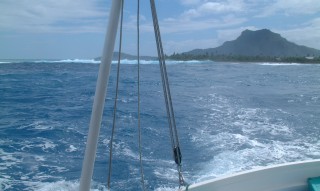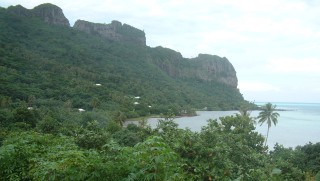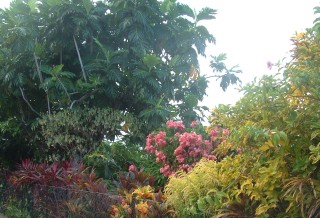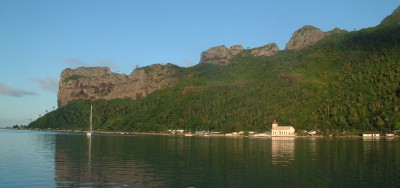
Click the map for a
Society Isles overview
|
Pacific Landfalls Fr. Polynesia Pages Related Pages |
Maupiti
 Click the map for a Society Isles overview |
Language: Tahitian, French
Population: 1,125
Money: French Polynesian Franc (but there are no banks, and not much to buy anyway)
Landscape: A volcanic spire of bare rock-faced cliffs and tropical
forest hanging over the main village.
Visited: April 30-May 5, 2004
This was our last French Polynesian island before jumping off for Tonga.
 The pass through the barrier reef looks like it's breaking all the way across its entrance |
(Jon) Like most atolls, Maupiti is an old volcanic island, now
surrounded by coral reef. This reef, while quite extensive, drops off
quite suddenly to very deep water. Getting into (and out of) Maupiti is
often quite a trick. Unfortunately, pictures from the boat just don't do
it justice. There is only 1 pass for getting in or out, located in the SE
corner. The pass is fairly narrow (about 200' or 60m) and rather shallow (about 25'
or 8m). When swells come up from the S or even the SE, they soon start
breaking, making both entering and exiting too dangerous for most boats.
Since Maupiti is about 25 miles dead down-wind from
Bora-Bora, you really don't want to sail all that
way and then discover you can't get in. Your only options then would be to
turn around and motor back upwind for 25 miles (likely arriving after dark) or
continuing west for several hundred (thousand) miles. Luckily, we found a
sailor in Bora-Bora whose family lives on one of the motus just next to the
entrance. He simply called his mom on a cell-phone and asked her what the
pass was like. She said it was calm that day, so off we went.
 Maupiti was small but surprisingly high & lush |
Even so, the pass was pretty hair-raising. Reefs SE of
the pass make it look like the pass is breaking, even when it
isn't. Also, all the waves breaking over the reef all the way around raise
the water level of the interior lagoon, so there is always a stiff current
flowing out the pass. Coming in, I was glad to have 2 nice big diesel
engines. When we got inside we found a Norwegian sailboat that had been
trapped inside for 2 weeks because the pass was breaking. Going out was
actually somewhat more thrilling, as the current generates a considerable rip
that extends well out into the ocean.
I quite enjoyed Maupiti. It's small enough to walk around
(getting some delightful views) and the people seemed friendly. Very few
yin a few hours achts stop there, so those that do get treated well. Going to their
church on Sunday & listening to the singing can be especially rewarding, as the
locals are likely to take you home for lunch. There's only 1 bakery and a
tiny store, so one hardly needs money (a good thing, since there's no bank).
(One strange thing I noticed is that virtually every house had a cemetery plot
out front. This must make it hard to either buy or sell a house.
What do you do with grandma?) Walking and exploring the motus is fun and
rewarding. A delightful stop before heading out on a
1,400 mile passage.
 Sweet-smelling flowers & beautiful trees grew everywhere, cultivated or not |
(Chris) I don't know if we'd initially intended to go to Maupiti, but we
were cruising with another boat and they stopped into Maupiti, so we decided to follow them.
Good decision! The island of Maupiti was very reminiscent of the Marquesas, with
a single-street village and every yard full of beautiful trees and bushes. I
really enjoyed walking the town and up a hill to a lookout over some of the
surrounding motus.
One thing I found interesting about Maupiti is that
watermelons are a principal crop. The island is wet enough, but the motus (where
the melons are grown) are dry! Still, it was interesting to walk around the
islands, looking at the little houses and plantations, and searching for shells.
 Coconut trees on Maupiti's mountain slopes |
(Amanda) Maupiti was a cute and gorgeously authentic island,
though my impression was slightly modified by my first trip ashore. Mom and I
were walking to the one little supermarket when this dirty old man comes out of
his house in his boxers and starts saying to us "I need a woman,
you know?" Ugh! It was disgusting at the time and hilariously funny back on the
boat. Another thing
I noticed ashore was that every single house we walked past
had a number of graves in the front yard. I thought it would be weird to say hi
to gramma and grampa every day as I left for school or whatever, but I guess
there was no community graveyard.
Surprisingly, the lagoon was extremely shallow and very
murky. We were anchored for most the time in about 25 feet of water, and I never
once saw the bottom. There were intermittent bommies that Mom and I swam over -
they dropped down into the gloom and I lost them at about ten feet. Maybe it was
so murky because it was so shallow? Or maybe it had something to do with
the strong current through the narrow, single pass. Whatever it was, the
only time I had seen a lagoon so murky was in Tahiti, right after a very long rain
storm.
 Maupiti's beautiful cliffs, lit by morning light |
(Sue) Maupiti's infamous pass keeps many cruising boats from entering (and if the weather and swells are bad, keeps them from leaving) so I felt lucky that we hit the conditions just right for a safe passage into the lagoon of this rarely-visited island. The cliffs above town give it a truly exotic feel, and it's small enough to be walked around in a few hours, which Jon and I did one late afternoon. We found good shelling on the motu beach to the east of the lagoon, but the mosquitoes and no-see-ums were fierce in the afternoon. On the main island apparently the bugs are not a problem, but on the motus where watermelons are cultivated there is standing water from the irrigation and the bugs multiply. This was a lovely send-off island from French Polynesia.
Marquesas Newsletters | Tuamotus Newsletters | FP Flora & Fauna
Top Level: Home | Destinations | Cruising Info | Underwater | Boat Guests | Ocelot | Sue | Jon | Amanda | Chris | Site Map | Make a Comment
|
If our information is useful, you can help by making a donation |
Copyright © 2000‑ Contact: Jon and Sue Hacking -- HackingFamily.com, svOcelot.com. All rights reserved.